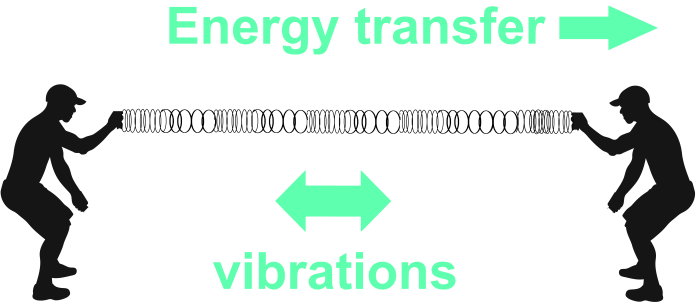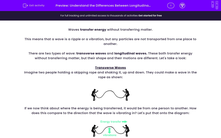Waves transfer energy without transferring matter.
This means that a wave is a ripple or a vibration, but any particles are not transported from one place to another.
There are two types of wave: transverse waves and longitudinal waves. These both transfer energy without transferring matter, but their shape and their motions are different. Let's take a look:
Transverse Waves
Imagine two people holding a skipping rope and shaking it, up and down. They could make a wave in the rope as shown:

If we now think about where the energy is being transferred, it would be from one person to another. How does this compare to the direction that the wave is vibrating in? Let's put that onto the diagram:
.png)
As you can see, the energy is being transferred from left to right, while the vibrations are up and down. This is a transverse wave because the direction of the energy transfer is at right angles (90º) to the direction of the vibrations.
Longitudinal waves
Let's use the same two people, but give them a slinky spring this time. They could make a wave by pushing forwards and backwards with their spring:

The wave that forms in this spring is made by regions that 'bunch up' and regions that spread out.
Now, let's consider the directions of energy transfer and vibration:

The spring is vibrating from side to side and the energy is being transferred from left to right. This is a longitudinal wave, because the vibrations and the energy transfer are parallel (in the same direction as each other).
Examples of each type of wave
There are many more examples of transverse wave than skipping ropes, and many more longitudinal waves than slinky springs.

Light is transverse. White light - as well as all the colours of the rainbow - is a transverse wave. In addition, all of the electromagnetic spectrum is transverse. This includes waves such as radio waves and X-rays. So too are the ripples that spread across the surface of water.

Sound is longitudinal. (Illustrated here with a roaring lion!). If you think about how sound works, it needs something to vibrate air molecules from one place to another, and as they vibrate, they collide into each other, transferring sound energy. Their vibrations and the energy transfer are in the same direction as each other.
Does that make sense?
Why not try some questions on it now?








